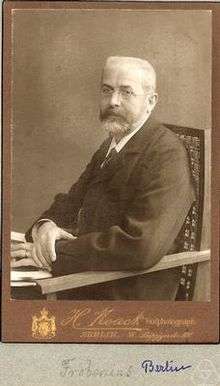Frobenius covariant
In matrix theory, the Frobenius covariants of a square matrix A are special polynomials of it, namely projection matrices Ai associated with the eigenvalues and eigenvectors of A.[1]:pp.403,437-8 They are named after the mathematician Ferdinand Frobenius.
Each covariant is a projection on the eigenspace associated with the eigenvalue λi. Frobenius covariants are the coefficients of Sylvester's formula, which expresses a function of a matrix f(A) as a matrix polynomial, namely a linear combination of that function's values on the eigenvalues of A.
Formal definition
Let A be a diagonalizable matrix with k distinct eigenvalues, λ1, …, λk.
The Frobenius covariant Ai, for i = 1,…, k, is the matrix
It is essentially the Lagrange polynomial with matrix argument. As an idempotent projection matrix to a one-dimensional subspace, it has a unit trace.
Computing the covariants

The Frobenius covariants of a matrix A can be obtained from any eigendecomposition A = SDS−1, where S is non-singular and D is diagonal with Di,i = λi. If A has no multiple eigenvalues, then let ci be the ith left eigenvector of A, that is, the ith column of S; and let ri be the ith right eigenvector of A, namely the ith row of S−1. Then Ai = ci ri.
If A has multiple eigenvalues, then Ai = Σj cj rj, where the sum is over all rows and columns associated with the eigenvalue λi.[1]:p.521
Example
Consider the two-by-two matrix:
This matrix has two eigenvalues, 5 and −2; hence (A−5)(A+2)=0.
The corresponding eigen decomposition is
Hence the Frobenius covariants, manifestly projections, are
with
Note trA1=trA2=1, as required.




